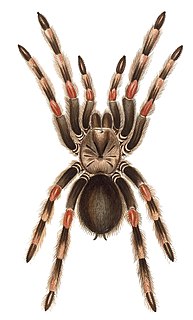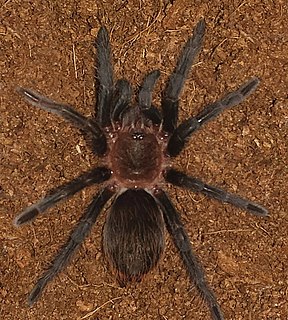
Avicularia is a genus of the family Theraphosidae containing various species of tarantulas. The genus is native to tropical Central and South America. Each species in the genus has very distinguishable pink foot pads.

Brachypelma is a genus of spiders in the family Theraphosidae (tarantulas). They may have bodies up to 6 cm long with legs of similar or greater lengths. Some species have brightly colored legs, with red or orange marks and rings.

Brachypelma hamorii is a species of tarantula found in Mexico. It has been confused with B. smithi; both have been called Mexican redknee tarantulas. Many earlier sources referring to B. smithi either do not distinguish between the two species or relate to B. hamorii. B. hamorii is a terrestrial tarantula native to the western faces of the Sierra Madre Occidental and Sierra Madre del Sur mountain ranges in the Mexican states of Colima, Jalisco, and Michoacán. The species is a large spider, adult females having a total body length over 50 mm (2 in) and males having legs up to 75 mm (3 in) long. Mexican redknee tarantulas are a popular choice for enthusiasts. Like most tarantulas, it has a long lifespan.

Brachypelma smithi is a species of spider in the family Theraphosidae (tarantulas) native to Mexico. It has been confused with Brachypelma hamorii; both have been called Mexican redknee tarantulas. Mexican redknee tarantulas are a popular choice as pets among tarantula keepers. Many earlier sources referring to B. smithi either relate to B. hamorii or do not distinguish between the two species. B. smithi is a terrestrial tarantula native to Pacific coast of the Mexican state of Guerrero.

Tliltocatl vagans is a species of tarantula known commonly as the Mexican red rump. It ranges predominantly in Mexico, but is also found in Central America. They are terrestrial, burrowing spiders. The reason for the name red rump is because of its distinctive red hairs on its abdomen. Like most tarantulas, they will eat anything they can overpower, which is usually insects, but small lizards and rodents may also be consumed. They can grow up to a solid 6.5 inch leg span, with males typically being smaller and thinner than the females. They prefer shrubland habitats.

Brachypelma klaasi is a tarantula endemic to Mexico and it is the rarest of the genus Brachypelma.

Aphonopelma chalcodes, commonly known as the western desert tarantula, Arizona blond tarantula or Mexican blond tarantula is a species of spider belonging to the family Theraphosidae. It has a limited distribution in the deserts of Arizona and adjacent parts of Mexico but can be very common within this range. The common name "blond tarantula" refers to the carapace, which is densely covered in pale hairs, and contrasts strongly with the all-dark legs and abdomen. The female body length is up to 56 mm, males only reaching 44 mm.

Tliltocatl albopilosus is a species of tarantula, also known as the curlyhair tarantula.

Brachypelma boehmei is a tarantula native to Mexico in Guerrero state. These long-lived tarantulas prefer burrowing and hiding in dry scrubland. As with all closely related tarantula species, they defend themselves with urticating hair when provoked.

The Mexican redleg or red-legged tarantula is a species of terrestrial tarantula closely related to the famous Mexican redknee tarantula. Like the redknee it is a docile tarantula and popular in the pet trade. It is slow growing and, like many tarantulas, females can live for decades.

Brachypelma albiceps is a species of spider in the tarantula family, Theraphosidae. It is known as the Mexican golden red rump tarantula or the Amula red rump tarantula. The carapace is a light golden color and the abdomen dark, covered with long red hairs. Females typically live for about 15 years. Males usually live about 5 years or up to 12 months after the last molt.

Aphonopelma anax, commonly known as the Texas tan tarantula, is a species of spider belonging to the family Theraphosidae native to southern Texas and northern Mexico.
Aphonopelma hollyi, also known as the Lubbock gold tarantula, is considered by some sources to be a species of tarantula native to Texas in the United States. Described in 1995, the scientific name honors the 1950s rock-and-roll singer Buddy Holly. Other sources suggest spiders given this name are actually Aphonopelma hentzi.

Sericopelma is a genus of tarantula, found in Central America from Nicaragua to Panama. The limits of the genus and its distribution have long been confused; it is closely related to the genus Aphonopelma. Sericopelma species are among the largest found in Central America. They can be kept as pets, although at least one species has been described as "very aggressive".

Tliltocatl epicureanus is a species of spider in the family Theraphosidae (tarantulas), found in the Yucatán Peninsula of Mexico.
Sandinista lanceolatum is a species of spider in the family Theraphosidae (tarantulas), native to Nicaragua and Costa Rica.

Tliltocatl schroederi is a species of spiders in the family Theraphosidae (tarantulas), found in Mexico. It is found in the central valley in Oaxaca State, Mexico.

Tliltocatl verdezi is a species of spiders in the family Theraphosidae (tarantulas), found in Mexico.

Tliltocatl is a genus of spiders in the tarantula family Theraphosidae. It was split off from Brachypelma in 2020. Species in Tliltocatl are found predominantly in Mexico, with some species native to Central America. They are large burrowing tarantulas, without the striking red leg markings of Brachypelma species.

Sericopelma embrithes is a tarantula that is native to Panama. To date, only specimens from Barro Colorado Island have been studied. Like other tarantulas, it is relatively large compared to other spiders. It can grow up to 59 mm long, including its chelicerae. S. embrithes is data deficient according to the IUCN.
















